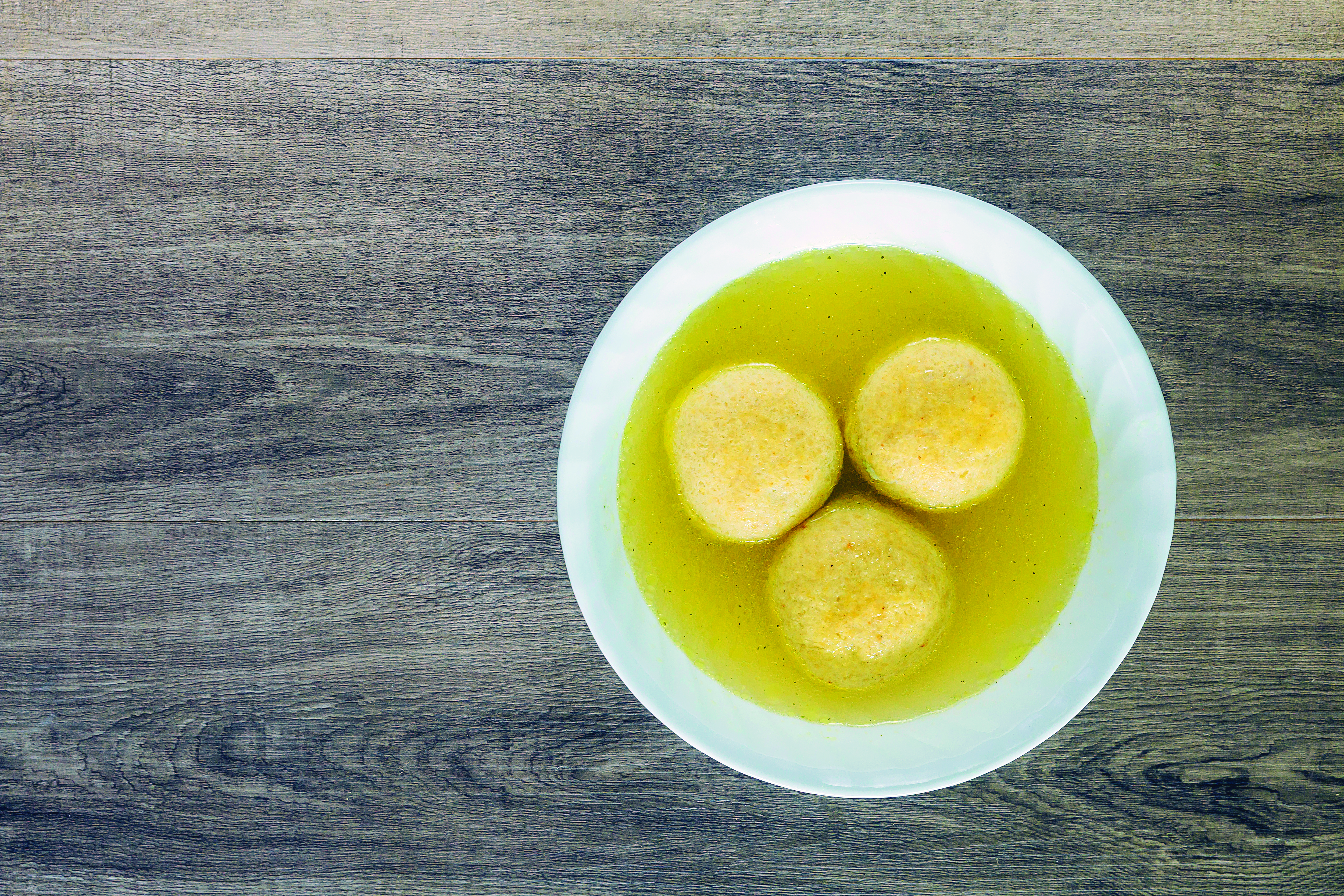
In last week’s column, I waxed poetic about chicken stock, so it seemed appropriate that I should follow up by telling you how I make matzo balls. Then you can use up all that glorious stock and schmaltz you will have in your freezer.
Each time I serve matzo ball soup, I see looks of ecstasy on the faces of my customers, because even non-Jews seem to have a deep, nostalgic love for soup with savory, fluffy dumplings.
Matzo balls — or kneidlach, as they are called in Israel — are Jewish soup dumplings that hail from Central and Eastern Europe. Of course, being a Jewish food means that no one can agree on a recipe, and you can find as many variations for matzo balls as for bread.
Matzo ball enthusiasts are separated by the controversy over their preference for “sinkers” or “floaters.” Sinkers are matzo balls that are heavy in the middle and quite al dente, whereas floaters are lighter and fluffier and usually much larger, like the size of a tennis ball, as opposed to the size of a golf ball.
In the United States and Israel, matzo ball mixes are very popular because it’s hard to beat the convenience of a dump-and-stir box. However, in the kosher section of most U. S. grocery stores, you can find matzo at any time of the year, and to make your own mix is not complicated or fussy.
The best matzo balls are made from coarsely ground matzo as opposed to the fine matzo meal powder that is in boxed mixes. If you have some matzo, a rolling pin or heavy object to crush them, making matzo into balls is just a matter of adding a few ingredients, stirring them up and you’re done. Making your own mix also enables you to control the salt content.
Because I’m a picky bugger, I enjoy matzo balls that are fluffy and al dente in the middle. I know that sounds like a contradiction, and my Romanian mother would disagree on this in principle — she likes floaters — but I like it when the outside of the matzo ball is fluffy (like a floater) and the inside of the ball still has a bit of a bite and is sinkerish.
This hybrid recipe is my preference both in my restaurant kitchen and at home. It’s pretty much a home run in the winter to serve in a steaming bowl of chicken soup with vegetables with plenty of chopped herbs floating about. It also is able to make any illness go away, fix a broken heart, and it’s more likely to put you in touch with your ancestors than a séance ever could. It’s comfort personified, and I don’t think I’m exaggerating one bit when I say it must be one of the foods of the Gods.
I hope this will demystify the matzo ball issue because these dumplings deserve to be eaten all year round and not just on Passover.
MATZO BALL SOUP
12 cups strong, seasoned chicken broth
4 eggs, beaten
1 cup matzo meal, coarsely pounded
to 1/4 of a pea size
1 1/2 teaspoons kosher salt (or to taste)
Freshly ground black pepper to taste
1/4 cup canola oil or schmaltz
(rendered chicken fat)
1/4 cup seltzer water or club soda
Beat 4 eggs in a bowl and then add matzo meal, salt, pepper, melted schmaltz (or oil) and seltzer water, and stir with a fork. Put the mixture in the refrigerator covered in plastic wrap for at least 2 hours or until ready to use.
When you want to cook your matzo balls, take the mixture out of the fridge; it should be hardened but still moist. Put about half of the seasoned chicken stock into a large pot with a tight-fitting lid. Make sure it’s large enough because these double in size and you don’t want to crowd them, or your matzo balls won’t fluff up. The other half of the chicken stock can be reserved for your soup.
When the stock is simmering, wet your hands with water and pinch off golf ball-size balls and immediately drop them into the hot stock. Work quickly, wetting your hands again as you go. If you don’t want to get your hands dirty, and you don’t mind quenelle-shaped matzo balls, use 2 spoons and scoop a bit of the mix out with one spoon, and then push it off with the other spoon into the simmering pot of stock. This method will result in a very light, irregularly shaped floater because you haven’t compacted the mix at all.
Once all the balls have been formed and dropped, bring your stock back to a simmer and cover the pot tightly with a lid. The pot can be quite full; the ideal is 3/4 full, but not too crowded, so the balls have room to expand.
The matzo balls will sink at first and then burst their lovely heads to the surface. From the time you have covered the pot, let them simmer approximately 50–60 minutes, or until they are soft all the way through and have a tad of give in the middle. You may have to sacrifice one to cut it open and see that it is cooked through.
Note that matzo balls simmered in stock will make your chicken soup cloudy. I don’t mind that sacrifice for the great taste the stock imparts to the matzo balls, but if you prefer clear broth, use the reserved stock to make soup to ladle on top of your matzo balls.
When the matzo balls are cooked, take them out of the stock with a slotted spoon and reserve until you want to serve them.
If you are making your matzo balls in advance of a meal and need to reheat them, transfer them back into the soup pot to cook in the simmering broth for a few minutes until heated through.
Word to the wise: Matzo balls are like sponges — don’t leave already-cooked matzo balls in soup for more than 5 minutes, because you will come back to find they have sucked up a lot of your soup and become soggy.
Serve with broth, vegetables and chopped dill and parsley in warmed bowls, and thank your nearest Jewish grandmother.
Makes about 12 matzo balls and 4 bowls of chicken soup.
Yamit Behar Wood, an Israeli-American food and travel writer, is the executive chef at the U.S. Embassy in Kampala, Uganda, and founder of the New York Kitchen Catering Co.






















 More news and opinions than at a Shabbat dinner, right in your inbox.
More news and opinions than at a Shabbat dinner, right in your inbox.